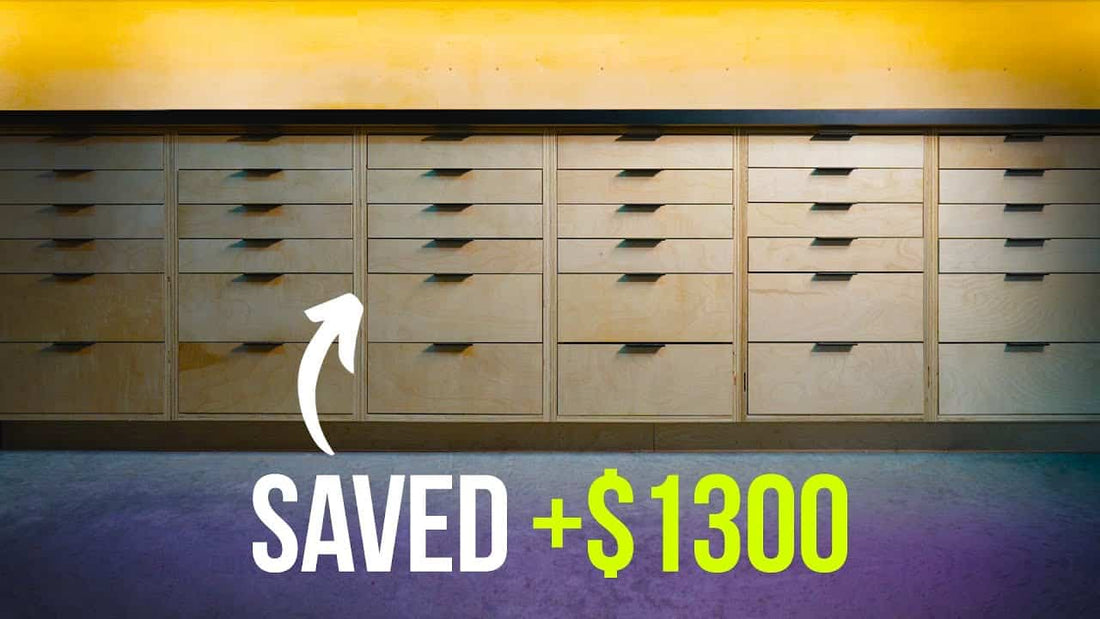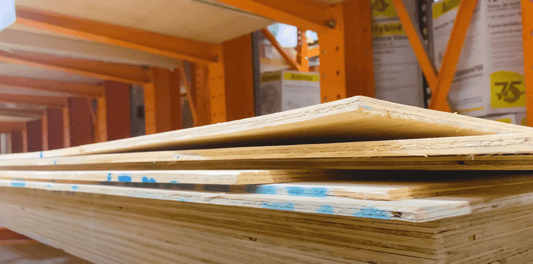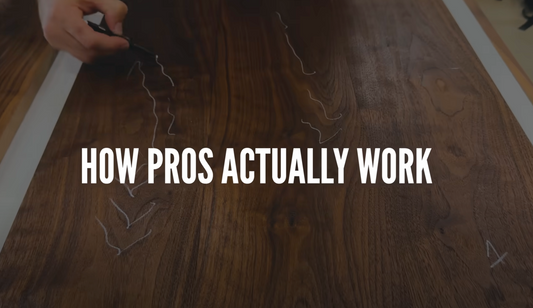
Drawer Slides Are Expensive. Do This Instead.
Share
Watch The Video Here
Building cabinets with traditional drawer slides can get expensive quickly. In this guide, I’ll show you how I built a 10-foot wall of cabinets without using drawer slides—and saved hundreds of dollars in the process. From smart plywood sourcing to design tricks, this project proves you don’t have to spend a fortune to get a professional-looking result.
Why Skip Drawer Slides?
Drawer slides are one of the most expensive components in any cabinet build. For my 10-foot wall, 36 sets of drawer slides would have cost between $900 and $1,300. That alone was more than my entire project budget.
Instead, I engineered a workaround using simple spacer blocks and smooth-bottom drawers that glide effectively without hardware.
Essential Tips for Cutting Plywood Accurately
When working with plywood and a track saw, precision is key. Here are 3 pro tips:
1. Clean Up the Factory Edge
Align your track about 3mm in from the damaged factory edge. Once cut, this becomes your reference edge for all future cuts—ensuring accuracy across the board.
2. Use Parallel Guides
These act like a table saw fence in your hand. They make repeatable cuts fast and consistent without measuring every time.
3. You Don’t Need a Long Track
A shorter track works just fine with parallel guides. You can reposition it after each cut to cover larger sheets.
Where to Find Quality Plywood (for Less!)
At big box stores, I found low-quality plywood priced at $79 per sheet with visible voids and warping. Instead, I sourced professional-grade plywood from a local supplier for about half the price.
Tip: Search for commercial plywood distributors in your area and ask for "shop-grade" or "pre-finished" panels.
How I Built the Cabinets (Without Slides)
The cabinet design is ultra-simple:
- 3 stretchers per cabinet
- A standalone toe kick
- No top or bottom panels
We added spacer blocks inside the frame to prevent the drawer bottoms from rubbing and to keep them gliding smoothly.
Building the Toe Kick
Rather than cutting a toe kick shape into the cabinet sides, I built it separately. This made it easier to level the cabinets on a sloped garage floor and gave a cleaner, more modular finish.
Leveling with Composite Shims
To level the cabinets, I used composite shims instead of wood. They were more consistent and made leveling the cabinets much easier and faster.
Aligning the Drawer Fronts
To get consistent spacing, I built a simple alignment jig from scrap plywood. It held each false front in place as I attached them.
Countertop Build: Budget Laminate Over MDF
The countertop is made from MDF and black laminate. It looks clean and modern, and costs much less than a butcher block or solid surface top.
Working with contact cement takes patience, but it’s manageable. Alternatively, you can buy pre-laminated MDF sheets to save time and hassle, but they’re more expensive.
Final Touches + Hardware
I tested each drawer and was pleased with how smooth they operated—no slides needed. To finish the look, I added sleek metal drawer pulls.
Total Cost Breakdown
While my initial goal was under $900, I ended up spending $1,444 total, which included:
- 10-foot cabinet wall
- Upper cabinets
- LED lighting
That’s still significantly cheaper than using traditional drawer slides.
Watch the Full Build Video
See the entire process in action on my YouTube channel: [Watch the build video here]
Want to continue to learn about built-in cabinets? [Then watch this video too]
Download the Cabinet Plans
Want to build your own drawer-slide-free cabinet system? [Click here to buy and download the digital plans]
Recap: How to Build Cabinets Without Drawer Slides
- ✅ Use parallel guides and a short track saw for accurate plywood cuts
- ✅ Source plywood from a local supplier for better price and quality
- ✅ Use spacer blocks to support drawers instead of slides
- ✅ Level cabinets with composite shims
- ✅ Finish with laminated MDF and modern hardware
FAQ: Drawer Slide Alternatives
-
Can you really build functional drawers without slides?
- Yes. With smooth-bottom drawers, spacers, and precise sizing, drawers can slide just fine on their own.
-
What do you use instead of drawer slides?
- Spacer blocks and smooth internal surfaces. You can also wax or lubricate the contact points.
-
Is it worth it to skip drawer hardware?
- Absolutely. It reduces cost and complexity while still producing functional, attractive cabinets.
🧰 Tools I used in the video (affiliate) 🧰
TSO Parallel Guides - http://t.ly/4qqjB
TSO GRS-16 Rail Square - https://tsoproducts.com/guide-rail-squares/grs-16-pe-parallel-edge-guide-rail-square/?ref=k4iBNSkj
Wall Mount Holders for TSO - https://wittworks.shop/collections/tso
3M Xtract Sandpaper - https://lddy.no/1fq8o
3M Xtract Sander - https://lddy.no/1dq8m
3M Xtract Extractor - https://lddy.no/1d3fr
Festool TS 60 KEB - https://amzn.to/3Yybtd3
Festool TSC 55 KEB - https://amzn.to/3rT18g3
Festool CT Midi - https://amzn.to/3bAdfpT
Powertec Ratchet Clamp - https://amzn.to/2TadnCZ
Bessey Ratchet Clamp - https://amzn.to/3bPnH9W
Bora Centipede 4x8 Base - https://amzn.to/3S7OUuE
Kreg Jig - https://amzn.to/3Q4aGg4
Kreg Sheet Goods Lifter Thingy - https://amzn.to/45HILbJ
5x12 Formica Sheet - https://amzn.to/3tHfbpm
Bastard File - https://amzn.to/45KdepA
Black Drawer Pulls - https://amzn.to/3MchxTv
LED Cabinet Lights - https://amzn.to/3s1cI8M



